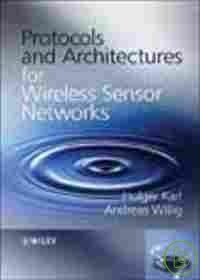- 定價87.00元
-
8
折優惠:HK$69.6

|
|
|
|
PROTOCOLS AND ARCHITECTURES FOR WIRELESS SENSOR NETWORKS
|

|

沒有庫存
訂購需時10-14天
|
|
|
|

|
|
9780470519233 | |
|

|
|
KARL | |
|

|
|
全華科技 | |
|

|
|
2008年1月01日
| |
|

|
|
453.00 元
| |
|

|
|
HK$ 430.35
|
|
|
|
|

| |
|
|
|
|
| |
|
|
詳
細
資
料
|
* 叢書系列:實用電子
* 規格:精裝 / 524頁 / 普級 / 單色印刷 / 初版
* 出版地:台灣
實用電子
|
|
分
類
|
[ 尚未分類 ] |
同
類
書
推
薦
|
|
|
內
容
簡
介
|
Protocols and Architectures for Wireless Sensor Networks provides a thorough description of the nuts and bolts of wireless sensor networks. The authors give an overview of the state-of-the-art, putting all the individual solutions into perspective with one and other. Numerous practical examples, case studies and illustrations demonstrate the theory, techniques and results presented. The clear chapter structure, listing learning objectives, outline and summarizing key points, help guide the reader expertly through the material. Protocols and Architectures for Wireless Sensor Networks: Covers architecture and communications protocols in detail with practical implementation examples and case studies. Provides an understanding of mutual relationships and dependencies between different protocols and architectural decisions. Offers an in-depth investigation of relevant protocol mechanisms. Shows which protocols are suitable for which tasks within a wireless sensor network and in which circumstances they perform efficiently. Features an extensive website with the bibliography, PowerPoint slides, additional exercises and worked solutions. This text provides academic researchers, graduate students in computer science, computer engineering, and electrical engineering, as well as practitioners in industry and research engineers with an understanding of the specific design challenges and solutions for wireless sensor networks.
本書特色
1 . Covers architecture and communications protocols in detail with practical implementation examples and case studies.
2 . Provides an understanding of mutual relationships and dependencies between different protocols and architectural decisions.
3 . Offers an in-depth investigation of relevant protocol mechanisms.
4 . Shows which protocols are suitable for which tasks within a wireless sensor network and in which circumstances they perform efficiently.
5 . Features an extensive website with the bibliography, PowerPoint slides, additional exercises and worked solutions.
|
|
目
錄
|
Preface.
List of Abbreviations.
A guide to the book.
1. Introduction.
1.1 The vision of Ambient Intelligence.
1.2 Application examples.
1.3 Types of applications.
1.4 Challenges for WSNs.
1.5 Why are sensor networks different?
1.6 Enabling technologies.
PART I: ARCHITECTURES.
2. Single node architecture.
2.1 Hardware components.
2.2 Energy consumption of sensor nodes.
2.3 Operating systems and execution environments.
2.4 Some examples of sensor nodes.
2.5 Conclusion.
3. Network architecture.
3.1 Sensor network scenarios.
3.2 Optimization goals & figures of merit.
3.3 Design principles for WSNs.
3.4 Service interfaces of WSNs.
3.5 Gateway concepts.
3.6 Conclusion.
PART II: COMMUNICATION PROTOCOLS.
4. Physical Layer.
4.1 Introduction.
4.2 Wireless channel and communication fundamentals.
4.3 Physical layer & transceiver design considerations in WSNs.
4.4 Further reading.
5. MAC Protocols 133
5.1 Fundamentals of (wireless) MAC protocols.
5.2 Low duty cycle protocols and wakeup concepts.
5.3 Contention-based protocols.
5.4 Schedule-based protocols.
5.5 The IEEE 802.15.4 MAC protocol.
5.6 How about IEEE 802.11 and Bluetooth?
5.7 Further reading.
5.8 Conclusion.
6. Link Layer Protocols.
6.1 Fundamentals: Tasks and requirements.
6.2 Error control.
6.3 Framing.
6.4 Link management.
6.5 Summary.
7. Naming and Addressing.
7.1 Fundamentals.
7.2 Address and name management in wireless sensor networks.
7.3 Assignment of MAC addresses.
7.4 Distributed assignment of locally unique addresses.
7.5 Content-based and geographic addressing.
7.6 Summary.
8. Time Synchronization.
8.1 Introduction to the time synchronization problem.
8.2 Protocols based on sender/receiver synchronization.
8.3 Protocols based on receiver/receiver synchronization.
8.4 Further reading.
9. Localization and Positioning.
9.1 Properties of positioning.
9.2 Possible approaches.
9.3 Mathematical basics for the lateration problem.
9.4 Single-hop localization.
9.5 Positioning in multi-hop environments.
9.6 Impact of anchor placement.
9.7 Further reading.
9.8 Conclusion.
10. Topology control 295
10.1 Motivation and basic ideas.
10.2 Flat network topologies.
10.3 Hierarchical networks by dominating sets.
10.4 Hierarchical networks by clustering.
10.5 Combining hierarchical topologies and power control.
10.6 Adaptive node activity.
10.7 Conclusions.
11. Routing protocols.
11.1 The many faces of forwarding and routing.
11.2 Gossiping and agent-based unicast forwarding.
11.3 Energy-efficient unicast.
11.4 Broadcast and multicast.
11.5 Geographic routing.
11.6 Mobile nodes.
11.7 Conclusions.
12. Data-centric and content-based networking 395.
12.1 Introduction.
12.2 Data-centric routing.
12.3 Data aggregation.
12.4 Data-centric storage.
12.5 Conclusions.
13. Transport Layer and Quality of Service.
13.1 The transport layer and QoS in wireless sensor networks.
13.2 Coverage and deployment.
13.3 Reliable data transport.
13.5 Block delivery.
13.6 Congestion control and rate control.
14. Advanced application support.
14.1 Advanced in-network processing.
14.2 Security.
14.3 Application-specific support.
Bibliography.
Index.
|
|
|
書
評
|
|
|
|
|

